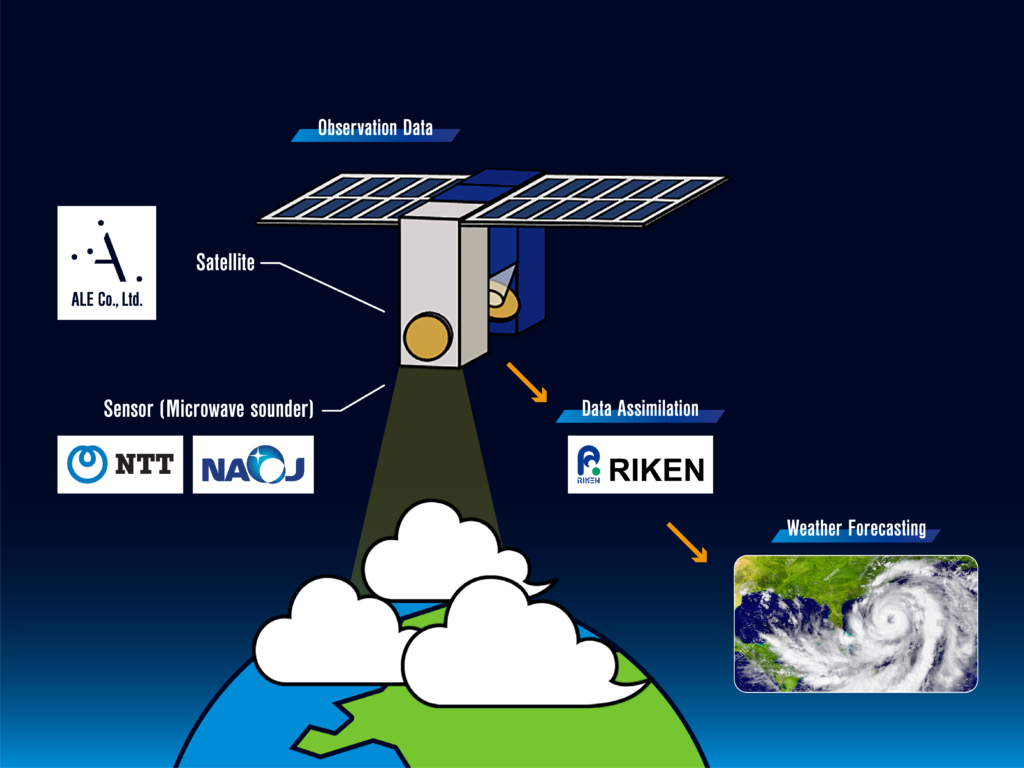Tokyo-based space technology startup ALE Co has partnered with NTT Device Technology Laboratories, RIKEN Center for Computational Science, and the National Astronomical Observatory of Japan (NAOJ) to develop a new generation of extreme weather early warning systems (EWS) as part of an industry-academia collaboration project named Aether.
Aether’s objective is to reduce unreasonable damage from disasters by utilizing data gathered by a weather satellite equipped with a newly developed small sensor for Earth observations.
It will be the first Japanese project to acquire observation data for weather forecasting using a commercial weather satellite. Until now, large government satellites have contributed to weather forecasting, however, they have become difficult to operate with a limited national budget.
Aether will develop a ‘microwave sounder’ to be equipped on CubeSat satellites to observe water vapor and temperature. With this additional data, Aether hopes to be able to contribute to disaster prevention and mitigation as part of the commercial sector. The satellite will complement the government’s large satellites by creating a ‘satellite constellation’.
According to the agreement, NTT and NAOJ will be responsible the research and development of the core components of the small microwave sounder. RIKEN will develop software for data assimilation and weather forecasting using its meteorological knowledge of large computer systems such as the supercomputer Fugaku.
ALE will oversee the overall coordination of hardware and satellite operations using space technology cultivated in other projects and will also oversee the business aspects of Aether to connect the technologies and knowledge of each organization to the new meteorological business.
The first step will be to develop elemental technologies, followed by a ground demonstration using a prototype, with the goal of a space demonstration within five years. Eventually, ALE plans to provide weather-related services from observation data to solution services based on weather forecasts.
Akira Okada, vice president, head of NTT Device Technology Laboratories, said, “NTT has been conducting research and development of InP-based transistor technology with superior high-speed performance, and has been contributing mainly to the advancement of communication systems. I am very grateful that the device technology we have developed has given us this opportunity to contribute to the new field of social safety and security, such as disaster prevention and weather forecasting.”
Takemasa Miyoshi, team leader, RIKEN Center for Computational Science, said, “I have been leading advanced research using the top-class supercomputers ‘K’ and Fugaku to revolutionize weather forecasting by utilizing new satellite data. I would like to connect this world-leading top science to the development of Aether’s sensors and weather forecasting systems, and contribute to the success of Japan’s commercial weather satellite business and the reduction of inexcusable disaster damage.”
Yoshinori Uzawa, the director of Advanced Technology Center, NAOJ, said, “We have contributed to the advancement of astronomy by developing highly sensitive radio receivers and installing them on the Nobeyama 45-meter telescope and the Atacama Large Millimeter/submillimeter Array (ALMA) in Chile. In addition, we have just established the Industry Liaison Office in order to utilize the technology for astronomy we have developed as technology that supports our daily lives for the benefit of society. I am very happy that our technology is expected to contribute to weather forecasting, which is indispensable for building a safe and secure society, and at the same time, I feel the weight of the role we need to fulfill.”
Lena Okajima, CEO, ALE Co, said, “We are delighted to be able to work with such a great group of people on this Aether project, which will help to solve social issues through scientific knowledge, with the aim of elucidating climate change and extreme weather events and using weather forecasting to prevent disasters.”



